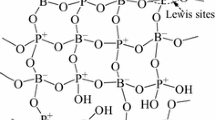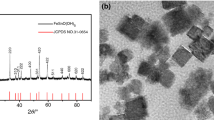Abstract
The effect of three metallic ferrites, LaFeO3, ZnFe2O4, and BiFeO3, on the thermal degradation and flame retardancy of flexible poly(vinyl chloride) (PVC) was investigated using thermogravimetric analysis (TG), differential thermal analysis, and TG coupled with Fourier transform infrared spectrometry. In combination with X-ray photoelectron spectroscopy techniques, the charring and flame-retardant mechanism has been obtained. The results show that compared with LaFeO3 and ZnFe2O4, BiFeO3 promoted the dehydrochlorination reaction of PVC more effectively and generated a large amount of stable char residue in a condensed phase. In the char residue of PVC/BiFeO3, the Fe2p spectra are assigned to FeCl2 and FeOCl, which acts as effective catalysts for the ionic dehydrochlorination of PVC owing to their strong Lewis acidity. Bi exists as BiOCl, which has a lower melting point and boiling point and can more easily decompose to form BiCl3 gas at the flame temperature. The results demonstrated that BiFeO3 can not only effectively inhibit the production of smoke from PVC during combustion, but it also has an effect similar to that of Sb2O3 in flame-retardant PVC.








Similar content being viewed by others
References
Levchik SV, Weil ED. Overview of the recent literature on flame retardancy and smoke suppression in PVC. Polym Adv Technol. 2005;16:707–16.
Rodolfo A Jr, Mei I, Helena L. Metallic oxides as fire retardants and smoke suppressants in flexible poly(vinyl chloride). J Appl Polym Sci. 2010;118:2613–23.
Qu HQ, Liu CH, Wu WH, Chen LZ, Xu JZ. Using cone calorimeter to study thermal degradation of flexible PVC filled with zinc ferrite and Mg(OH)2. J Therm Anal Calorim. 2014;115:1081–7.
Etienne S, Becker C, Ruch D, Germain A, Calberg C. Synergetic effect of poly(vinyl butyral) and calcium carbonate on thermal stability of poly(vinyl chloride) nanocomposites investigated by TG–FTIR–MS. J Therm Anal Calorim. 2010;100:667–77.
Awad WH, Wilkie CA. Investigation of the thermal degradation of polyurea: the effect of ammonium polyphosphate and expandable graphite. Polymer. 2010;5:2277–85.
Feng J, Hao JW, Du JX, Yang RJ. Using TGA/FTIR TGA/MS and cone calorimetry to understand thermal degradation and flame retardancy mechanism of polycarbonate filled with solid bisphenol A bis(diphenyl phosphate) and montmorillonite. Polym Degrad Stab. 2012;97:605–14.
Han LJ, Wu WH, Qu HQ, Han X, Wang AQ, Jiao YH, Xu JZ. Metallic ferrites as flame retardants and smoke suppressants in flexible poly(vinyl chloride). J Therm Anal Calorim. 2015;. doi:10.1007/s10973-015-4855-y.
Pi H, Guo SY, Ning Y. Mechanochemical improvement of the flame-retardant and mechanical properties of zinc borate and zinc borate-Aluminum trihydrate-filled poly(vinyl chloride). J Appl Polym Sci. 2003;89:753–62.
Qu HQ, Wu WH, Zheng YJ, Xie JX, Xu JZ. Synergistic effects of inorganic tin compounds and Sb2O3 on thermal properties and flame retardancy of flexible poly(vinyl chloride). Fire Saf J. 2011;46:462–7.
Starnes WH Jr, Pike RD, Cole JR, Doyal AS, Kimlin EJ, Lee JT, Murray PJ, Quinlan RA, Zhang J. Cone calorimetric study of copper-promoted smoke suppression and fire retardance of poly(vinyl chloride). Polym Degrad Stab. 2003;82:15–24.
McNeill IC, Memetea L, Cole WJ. A study of the products of PVC thermal degradation. Polym Degrad Stab. 1995;49:181–91.
Zhu H, Wang W, Liu TX. Effects of copper-containing layered double hydroxide on thermal and smoke behavior of poly(vinyl chloride). J Appl Polym Sci. 2011;122:273–81.
Qu HQ, Wu WH, Xie JX, Xu JZ. A novel intumescent flame retardant and smoke suppression system for flexible PVC. Polym Adv Technol. 2011;22:1174–81.
Pike RD, Starnes WH Jr, Jeng JP, Bryant WS, Kourtesis P, Adams CW. Low-valent metals as reductive cross-linking agents: a new strategy for smoke suppression of poly(vinyl chloride). Macromolecules. 1997;30:6957–65.
Yoshioka T, Akama T, Uchida M, Okuwaki A. Analysis of two stages dehydrochlorination of poly(vinyl chloride) using TG-MS. Chem Lett. 2000;29:322–3.
Beneš M, Milanov N, Matuschek G, Kettrup A, Placek V, Balek V. Thermal degradation of PVC cable insulation studied by simultaneous TG-FTIR and TG-EGA methods. J Therm Anal Calorim. 2004;78:621–30.
Wang XD, Zhang Q. Effect of hydrotalcite on the thermal stability, mechanical properties, rheology and flame retardance of poly(vinyl chloride). Polym Int. 2004;53:698–707.
Zhu HM, Jiang XG, Yan JH, Chi Y, Cen KF. TG-FTIR analysis of PVC thermal degradation and HCl removal. J Anal Appl Pyrol. 2008;82:1–9.
Feng JX, Zhang XM, Ma SQ, Xiong Z, Zhang CZ, Jiang YH, Zhu J. Syntheses of metallic cyclodextrins and their use as synergists in a poly(vinyl alcohol)/intumescent flame retardant system. Ind Eng Chem Res. 2013;52:2784–92.
Huang GB, Liang HD, Wang Y, Wang X, Gao JR, Fei ZD. Combination effect of melamine polyphosphate and graphene on flame retardant properties of poly(vinyl alcohol). Mater Chem Phys. 2012;132:520–8.
Qu HQ, Wu WH, Jiao YH, Xu JZ. Thermal behavior and flame retardancy of flexible poly(vinyl chloride) treated with Al(OH)3 and ZnO. Polym Int. 2005;54:1469–73.
Carty P, Metcalfe E, While S. A review of the role of iron containing compounds in char forming/smoke suppressing reactions during the thermal decomposition of semi-rigid poly(vinyl chloride) formulations. Polymer. 1992;33:2704–8.
Acknowledgements
The work was financially supported by the Natural Science Foundation of China (Grant No. 21306035 and Grant No. 21276059).
Author information
Authors and Affiliations
Corresponding author
Rights and permissions
About this article
Cite this article
Qi, Y., Wu, W., Han, L. et al. Using TG-FTIR and XPS to understand thermal degradation and flame-retardant mechanism of flexible poly(vinyl chloride) filled with metallic ferrites. J Therm Anal Calorim 123, 1263–1271 (2016). https://doi.org/10.1007/s10973-015-5084-0
Received:
Accepted:
Published:
Issue Date:
DOI: https://doi.org/10.1007/s10973-015-5084-0




